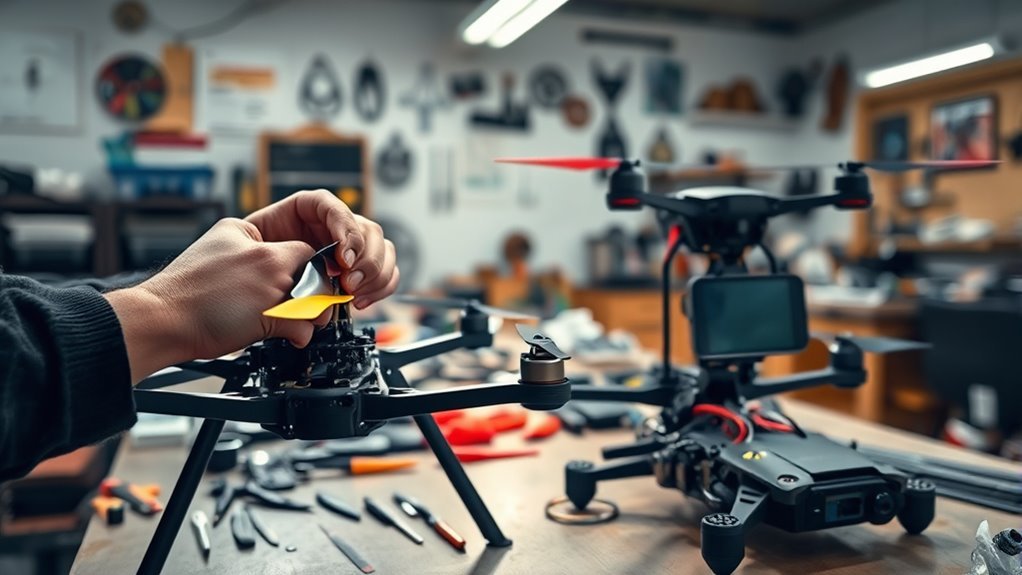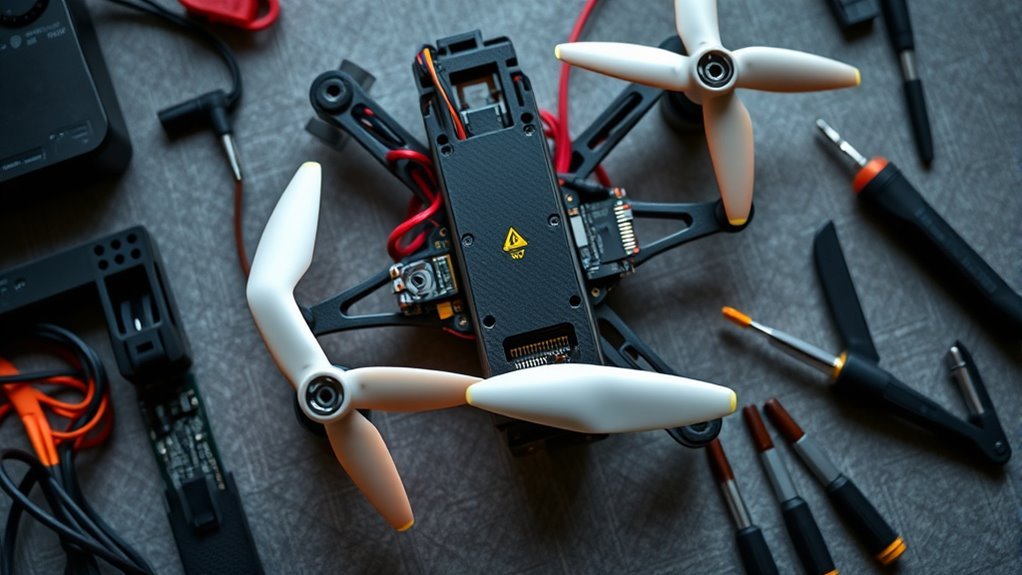To make a drone, start by understanding its core components like the frame, motors, and flight controller. Gather essential tools such as a soldering iron and multimeter. Choose the right frame type based on your needs, then securely install the motors and propellers. Configure the flight controller settings and wire the electronic speed controllers properly. Once everything’s in place, calibrate your drone and conduct test flights. Continue exploring detailed steps to guarantee peak performance and safety.
Understanding Drone Components

To build a drone, it is essential to grasp its core components. You’ll encounter various drone types, including multi-rotors, fixed-wing, and hybrid models, each serving distinct purposes. Understanding these classifications helps you determine the specific components you’ll need. The primary elements include the frame, motors, electronic speed controllers (ESCs), flight controller, and battery. Familiarity with these components enables you to customize your drone for peak performance. Additionally, you’ll need to stay informed about drone regulations in your area, as they dictate safe operation and compliance. Whether you’re pursuing aerial photography or recreational flying, a solid grasp of these fundamentals will empower your creative freedom while ensuring safety and legality in your drone endeavors. Furthermore, understanding battery endurance is crucial for optimizing flight time and efficiency in your drone projects. For instance, considering flight time capabilities of different models can significantly influence your drone’s performance based on its intended use.
Gathering Essential Tools

Before you start assembling your drone, it’s vital to gather all the essential tools and materials. Begin by compiling a required materials checklist to guarantee you have everything on hand, including tools for assembly and necessary safety equipment. This preparation will streamline the building process and enhance your overall efficiency.
Required Materials Checklist
As you begin building your drone, assembling the right tools and materials is essential for a successful project. Understanding drone technology and flight mechanics is fundamental, so verify you have everything on this checklist:
| Material | Purpose |
|---|---|
| Frame | Structure for components |
| Motors | Propulsion and lift |
| Propellers | Generate thrust for flight |
| Flight Controller | Central processing unit |
| Battery | Power source for operation |
Gathering these components will equip you to navigate the complexities of drone assembly. Each item plays an important role in confirming your drone operates efficiently and adheres to flight mechanics principles. With the right materials, you’ll reveal the potential for creative freedom in your aerial endeavors.
Tools for Assembly
Having the right tools is crucial for effectively assembling your drone. An essential tools overview includes a soldering iron for electrical connections, a multimeter for testing circuits, and a precision screwdriver set for mounting components. Additionally, a hot glue gun can secure fragile parts, while a pair of wire cutters is important for trimming excess wiring. For drone assembly techniques, confirm you have pliers for bending and manipulating materials, and use a soft brush to clean dust from components. Investing in a quality workspace with adequate lighting can enhance your assembly experience, allowing you to focus on precision. By gathering these tools, you’ll empower yourself to create a drone that reflects your vision of freedom and innovation.
Safety Equipment Essentials
While gathering tools for assembly, it’s equally important to prioritize safety equipment to secure a safe working environment. Start by acquiring personal protective gear, such as safety goggles, gloves, and a dust mask, to shield yourself from potential hazards. These items are essential in preventing injuries from sharp components or chemical exposure during assembly. Additionally, make sure you have a first aid kit readily available, as it can be vital during unforeseen accidents. Familiarize yourself with emergency safety procedures to respond quickly and effectively should an incident occur. By equipping yourself with the right safety gear and knowledge, you’ll not only enhance your freedom in the assembly process but also create a safer workspace for yourself and others.
Choosing the Right Frame

The frame is the backbone of your drone, determining its stability, weight distribution, and overall performance. When choosing the right frame, consider frame materials like carbon fiber for strength and weight efficiency, or plastic for cost-effectiveness. Frame sizes vary; larger frames can accommodate bigger payloads while smaller ones enhance agility. Think about frame designs, too—X, H, or Y configurations each offer different handling characteristics. Frame weight plays a vital role; a lighter frame improves flight time but may compromise durability. Ultimately, balance your needs for weight, strength, and design to achieve the freedom of flight you desire. A well-chosen frame paves the way for a successful drone-building experience, setting the foundation for all subsequent components.
Installing the Motors and Propellers
Begin by carefully installing the motors and propellers, as this step markedly influences your drone’s flight performance. Guarantee precise motor placement according to your frame design. Typically, you’ll position them at the corners of the frame, maintaining a symmetrical layout for balanced thrust. Pay attention to propeller orientation; clockwise (CW) and counterclockwise (CCW) propellers must be matched correctly to their respective motors for ideal lift and stability. Secure the motors using screws, ensuring they’re tightly fastened to prevent vibration during flight. After mounting, attach the propellers, confirming they are aligned with the motor direction. Double-check all connections and orientations before proceeding. This meticulous approach will enhance your drone’s aerodynamics and overall functionality, giving you the freedom to explore the skies confidently.
Setting Up the Flight Controller
When setting up your flight controller, you need to start by choosing the right model that suits your drone’s specifications. Next, you’ll focus on the wiring connections, ensuring each component is properly linked for maximum performance. Finally, configuring the software settings will allow you to fine-tune the drone’s flight characteristics and responsiveness.
Choosing the Right Controller
Choosing the right flight controller is essential for guaranteeing your drone operates effectively and responds accurately to your commands. Start by evaluating the various controller types available, such as multi-rotor, fixed-wing, and hybrid systems. Each type has unique capabilities suited to different flying styles and purposes. Next, consider compatibility considerations; verify the controller can interface with your chosen motors, sensors, and other components. Pay attention to firmware options, as many controllers offer customizable settings that can enhance performance and flying experience. Finally, look for user reviews and community feedback to gauge reliability and support. Making an informed choice will empower you to release your drone’s full potential and enjoy the freedom of flight.
Wiring Connections Explained
After selecting the right flight controller, the next step involves establishing the wiring connections vital for effective communication between components. You’ll need to consult wiring diagrams specific to your flight controller model to understand the connection types required. Typically, you’ll find connections for power, signal, and ground wires. Pay close attention to the polarity of your connections; incorrect wiring can lead to permanent damage. Use color-coded wires to simplify the process and guarantee each connection is secure. As you wire each component, refer back to the diagrams frequently to avoid mistakes. This foundational step is essential for achieving peak performance and reliability in your drone, granting you the freedom to explore the skies with confidence.
Configuring Software Settings
Configuring the software settings for your flight controller is essential for ideal drone performance. You’ll want to guarantee software compatibility with your hardware to avoid issues. Here are three key steps to guide you through the configuration process:
- Select Configuration Software: Use a compatible application, like Betaflight or ArduPilot, that suits your flight controller.
- Adjust PID Settings: Fine-tune the Proportional, Integral, and Derivative values to optimize stability and responsiveness during flight.
- Set Flight Modes: Configure various flight modes that enhance your flying experience, allowing for greater freedom and control in different environments.
Taking the time to explore these configuration options will greatly improve your drone’s performance and responsiveness in the air.
Wiring the Electronic Speed Controllers
Wiring the Electronic Speed Controllers (ESCs) is a critical step in guaranteeing your drone’s performance and responsiveness. Proper ESC placement is essential; position each ESC close to the corresponding motor for minimal wire length and peak efficiency. Start by using reliable soldering techniques to connect the three motor wires to each ESC. Verify your solder joints are clean and secure to prevent any disconnections during flight. Next, connect the ESCs to the flight controller, making sure you follow the correct signal and power connections. Double-check polarity to avoid damaging components. Finally, use heat shrink tubing or electrical tape to insulate your connections, safeguarding against short circuits. This meticulous approach will enhance your drone’s reliability and responsiveness in the air.
Calibrating Your Drone
Calibrating your drone is essential for ideal flight performance, and there are several key steps you’ll need to follow. Proper calibration techniques guarantee accurate sensor adjustments, leading to stable flights. Here’s how to get started:
- Compass Calibration: Rotate your drone horizontally and vertically to align the compass with Earth’s magnetic field.
- Accelerometer Calibration: Place your drone on a level surface and follow the prompts in your flight app to adjust the accelerometer.
- Gyroscope Calibration: Power on your drone and let it sit still until the gyroscope stabilizes, usually indicated by a solid LED light.
Testing and Flying Your Drone
Once you’ve completed the calibration process, it’s essential to test and fly your drone in a controlled environment. Begin with a thorough pre-flight checklist: verify battery levels, check propeller integrity, and guarantee your remote control’s functionality. Selecting an open area with minimal obstructions will enhance safety during your flight test. Gradually power up your drone, observing its response to controls. Start with short, low-altitude flights to assess stability and handling. Monitor for any unusual behaviors such as drift or erratic movements. If issues arise, recalibrate or troubleshoot before proceeding. Once comfortable, you can explore more advanced maneuvers, but always prioritize safety and compliance with local regulations, guaranteeing your newfound freedom in the skies remains enjoyable and responsible. Additionally, ensure you are aware of designated areas for drone operation to avoid any legal complications. Furthermore, consider integrating features like AI-driven obstacle avoidance for improved safety during your test flights.
Frequently Asked Questions
What Is the Legal Age to Fly a Drone?
When considering drone safety, you should know that age requirements vary by country. In the U.S., you must be at least 13 to register, but local regulations might impose stricter age limits. Always check first.
Can I Use a Drone for Commercial Purposes?
Yes, you can use a drone for commercial purposes, but you’ll need to comply with drone licensing requirements. Understanding these regulations is essential for successful commercial drone applications and ensuring your operations remain lawful and efficient.
How Do I Register My Drone?
Registering your drone’s like securing a passport for your aerial adventures. You’ll need to navigate the drone registration process through online registration platforms, ensuring compliance with regulations while enjoying your newfound freedom in the skies.
What Are the Common Drone Regulations I Should Know?
You should know that common drone regulations focus on drone safety and privacy concerns. Adhering to altitude limits, no-fly zones, and respecting others’ privacy rights will guarantee you fly responsibly while enjoying your freedom.
How Can I Troubleshoot Flight Issues?
When your drone’s flying like a bird caught in a storm, check the battery calibration and guarantee propeller alignment is spot on. These tweaks can restore smooth flight, letting you soar freely once more.

